The 82nd (2023) Nevada Legislature will begin on February 6, 2023. To date, there are three water bills and 18 bill draft requests (BDRs) that have been submitted by Legislators. Detailed language for BDR’s is still being developed and not yet available. This article will focus on one water bill and three BDR’s that are most important to CNRWA and its member counties.
Assembly Bill 34 which revises requirements for certain notices and court orders published in newspapers, will primarily impact rural counties. The Division of Water Resources requested this measure because newspapers in rural Nevada do not always publish public notices resulting in delays in processing water right applications and other administrative actions. AB34 provides that if a newspaper of general circulation fails to publish the notice or order submitted by the State Engineer the required number of times or consecutively, the State Engineer is not required to republish the notice or order if the notice or order is published at least once by the newspaper and the State Engineer mails the notice or order to not less than one public library in an affected county or counties or, if there is no public library, another public place, for public posting. CNRWA will work to ensure ample public notice is continued in rural counties.
BDR #338 submitted by the Joint Interim Standing Committee on Natural Resources is to clarify the processes and authority for the conjunctive management of surface and groundwater basins.
This BDR will be one of the more complex and controversial water issues debated this Session. The Central Nevada Regional Water Authority’s policy is that conjunctive management of hydrologically connected water resources is generally appropriate and warranted but may not be in select cases and should only be implemented after a complete vetting with local and public coordination of how issues and impacts will be worked through. The policy also states that conjunctive management is important to protect existing water rights and the integrity of the prior appropriation system and should occur at the most local level possible where the unique set of conditions is well understood and where interested water users can efficiently and fully participate and remain informed.
Another conjunctive water management measure, BDR #208, authorizes the State Engineer to create, modify, and jointly administer basin boundaries. BDR #208 is in response to the 8th Judicial District Court ruling on State Engineer Order 1309 for the Lower White River Flow System (LWRFS). The ruling now on appeal to the Nevada Supreme Court states that the Nevada State Engineer had no authority based in statute to create the LWRFS superbasin out of multiple distinct, already established hydrographic basins and that the Nevada State Engineer lacked the statutory authority to conjunctively manage this LWRFS superbasin. The threshold issue that will need to be addressed is how the priority of water rights in individual hydrographic basins would be managed in a combined basin, i.e., a senior right water right in a single basin may no longer have the same priority in a superbasin.
Groundwater management planning in Critical Management Areas (CMA) is another important water issue that will be considered. Diamond Valley in Eureka County is the only basin in Nevada that has been designated as a CMA. BDR #595 is in response to the Nevada Supreme Court ruling last spring that the State Engineer has the discretion to approve a groundwater management plan (GMP) that departs from the doctrine of prior appropriations. The State Engineer’s approval of the Diamond Valley GMP was appealed to the District Court, which found that the approval was unlawful. The District Court’s finding was then appealed to the Nevada Supreme Court which opined that Nevada statutes give the State Engineer discretion to approve a GMP that does not strictly comply with Nevada’s statutory water scheme or strictly adhere to the doctrine of prior appropriation. While the Diamond Valley GMP is specific to Diamond Valley it is possible that other CMA’s will be designated in the future prompting the need for clarification on the parameters of a CMA.
CNRWA has also requested the following BDR’s for the upcoming Legislative Session: funding for counties to prepare and update water resource plans, authority for a board of county commissioners to establish a groundwater board for areas designated as a groundwater basin by the State Engineer, assuring that special groundwater assessments are being used for administration of designated groundwater basins, and funding for the voluntary retirement of water rights in overpumped groundwater basins.
You can visit the Legislative website at: leg.state.nv.us for information about bills and also how to view committee meetings and provide testimony. You can also check out the Central Nevada Regional Water Authority website at cnrwa.com for regular updates.
Jeff Fontaine is the Executive Director of the Central Nevada Regional Water Authority whose members include Churchill, Elko, Esmeralda, Eureka, Humboldt, Lander, Nye, Pershing and White Pine Counties. CNRWA’s mission is to protect the water resources in member counties so these counties will not only have an economic future, but their valued quality of life and natural environment is maintained. CNRWA formulates and presents a united position on water and water-related issues to the Nevada legislature.
By Jeff Fontaine | Executive Director | CNRWA | ccjfontaine@gmail.com

